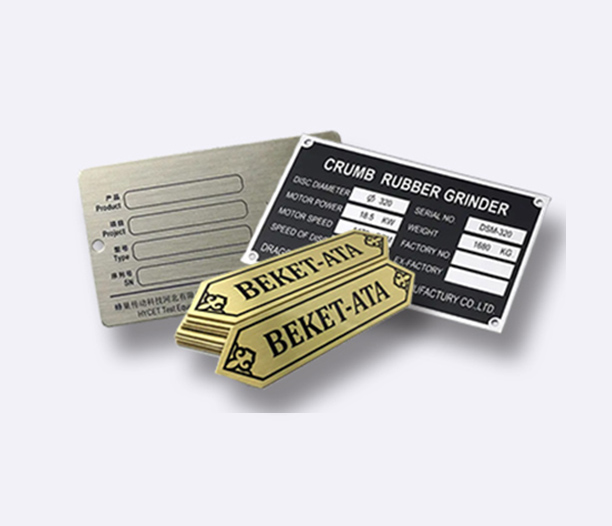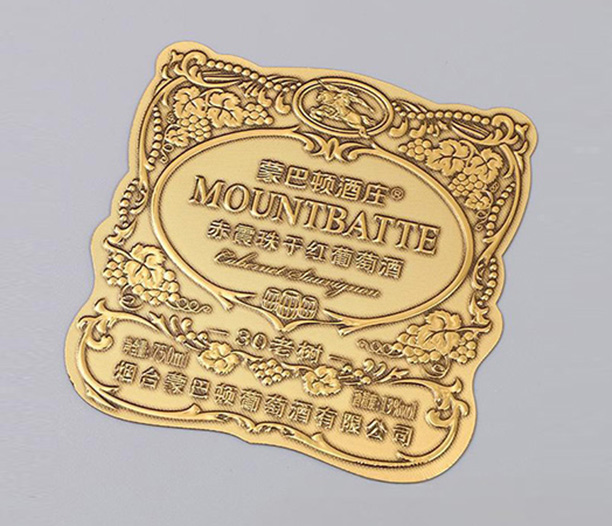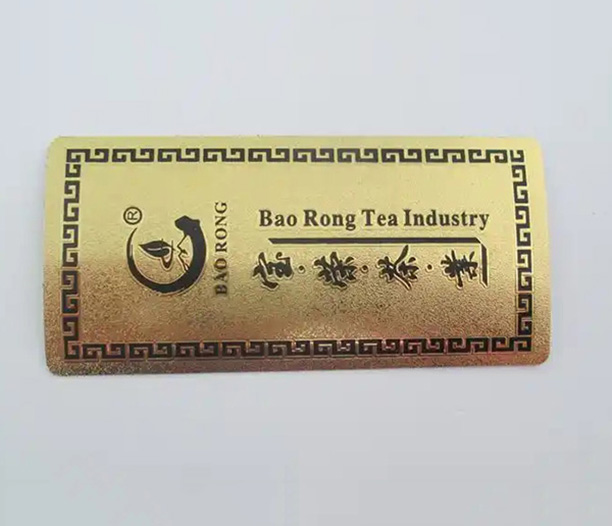In the world of industrial machinery, commercial equipment, and even consumer products, identification and information display are critical for safety, compliance, and efficiency. Metal equipment nameplates serve as durable, reliable labels that provide essential details such as model numbers, serial numbers, safety warnings, and manufacturer information. These nameplates are not just simple tags; they are integral components that enhance equipment longevity, ensure regulatory adherence, and facilitate seamless operations. This article delves into the multifaceted aspects of metal equipment nameplates, covering their types, materials, manufacturing processes, applications, benefits, and selection criteria. By understanding these elements, businesses and individuals can make informed decisions when incorporating metal equipment nameplates into their assets.
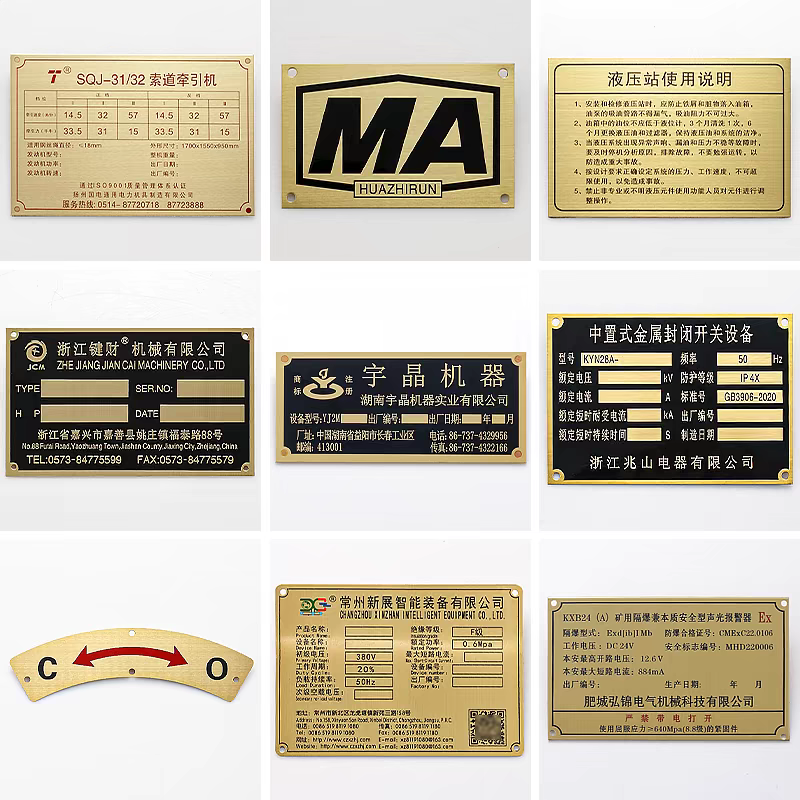
What Are Metal Equipment Nameplates?
Metal equipment nameplates are specialized labels or plates made from various metals, designed to be affixed to equipment for identification, instruction, or branding purposes. They are commonly used in industries such as manufacturing, automotive, aerospace, and healthcare to display information that must withstand harsh environments, including extreme temperatures, moisture, chemicals, and physical abrasion. Typically, metal equipment nameplates include details like product specifications, safety guidelines, certification marks, and logos. Their primary function is to provide clear, permanent communication that aids in maintenance, troubleshooting, and compliance with industry standards. Unlike plastic or paper labels, metal equipment nameplates offer superior durability, making them ideal for long-term use in demanding settings. Whether on heavy machinery, electrical panels, or medical devices, these nameplates ensure that critical information remains legible and intact over time, reducing the risk of errors and enhancing overall safety.
Types and Materials of Metal Equipment Nameplates
Metal equipment nameplates come in a variety of types and materials, each suited to specific applications and environmental conditions. The choice of material often depends on factors like corrosion resistance, cost, aesthetics, and durability. Common materials include aluminum, stainless steel, brass, and zinc, each offering unique advantages. Aluminum nameplates are lightweight, corrosion-resistant, and easy to customize, making them popular for indoor equipment and consumer products. Stainless steel nameplates, on the other hand, excel in harsh environments due to their high strength and resistance to rust, chemicals, and heat—ideal for industrial machinery or outdoor use. Brass nameplates provide a classic, elegant appearance and good durability, often used in decorative or heritage applications. Zinc nameplates are cost-effective and offer decent corrosion resistance, suitable for mass-produced items. Additionally, metal equipment nameplates can be further categorized based on their attachment methods, such as adhesive-backed, riveted, or screwed-on plates. Some nameplates feature embossed or engraved text for added texture and longevity, while others use digital printing or etching for high-resolution graphics. Understanding these variations helps in selecting the right metal equipment nameplates for specific needs, ensuring optimal performance and compliance.
Manufacturing Processes for Metal Equipment Nameplates
The production of metal equipment nameplates involves several advanced manufacturing processes that ensure precision, durability, and customization. Key techniques include etching, stamping, engraving, and printing, each contributing to the final product's quality and functionality. Etching is a chemical process that removes layers of metal to create detailed designs, logos, or text, resulting in a smooth, permanent finish that resists fading. Stamping, often used for high-volume orders, involves pressing a die into the metal to form raised or recessed characters, providing a tactile feel and excellent durability. Engraving uses mechanical tools or lasers to cut directly into the metal surface, offering deep, legible markings that withstand abrasion and environmental stressors. For color and complex graphics, printing methods like screen printing or digital UV printing are employed, often combined with protective coatings to prevent wear. Post-processing steps, such as anodizing for aluminum or plating for brass, enhance corrosion resistance and aesthetic appeal. Quality control is integral to these processes, ensuring that each metal equipment nameplate meets industry standards for readability and longevity. By leveraging these manufacturing techniques, producers can create customized metal equipment nameplates that align with client specifications, whether for simple identification or complex instructional panels.
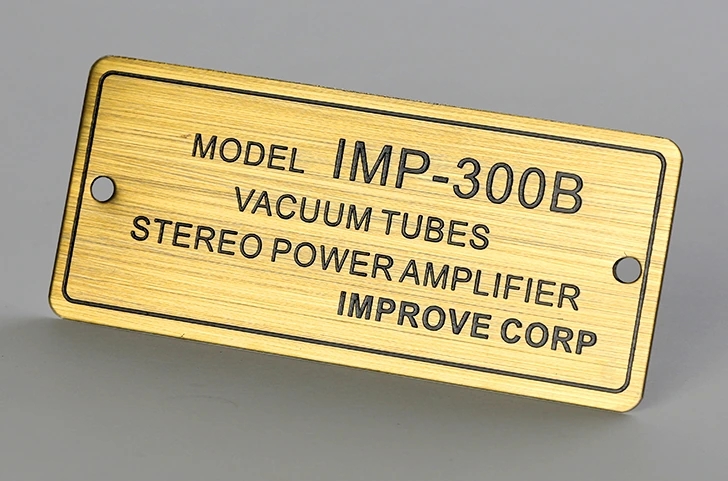
Applications of Metal Equipment Nameplates in Various Industries
Metal equipment nameplates find widespread use across diverse industries due to their versatility and resilience. In the manufacturing sector, they are attached to machinery, conveyor systems, and tools to display operational parameters, safety warnings, and part numbers, facilitating efficient maintenance and reducing downtime. The automotive industry relies on metal equipment nameplates for vehicle identification numbers (VINs), engine specifications, and compliance labels, which must endure exposure to oils, temperatures, and vibrations. In aerospace, these nameplates are critical for components like aircraft engines and avionics, where they provide traceability and safety information under extreme conditions. The healthcare field uses metal equipment nameplates on medical devices, such as MRI machines and surgical instruments, to ensure sterility, regulatory compliance, and accurate usage instructions. Additionally, consumer goods, including appliances and electronics, incorporate metal nameplates for branding and model details, enhancing product appeal and user safety. Even in construction and energy sectors, metal equipment nameplates are essential for labeling electrical panels, pipelines, and renewable energy systems, helping to prevent accidents and ensure regulatory adherence. This broad applicability underscores the importance of metal equipment nameplates in maintaining operational integrity and safety across global markets.
Benefits of Using Metal Equipment Nameplates
The advantages of using metal equipment nameplates are numerous, contributing to their popularity in various applications. Firstly, durability is a standout benefit; metal nameplates can withstand harsh conditions, including UV exposure, chemicals, and physical impact, ensuring that information remains readable for years. This longevity reduces replacement costs and minimizes the risk of information loss, which is crucial for safety-critical environments. Secondly, metal equipment nameplates offer excellent customization options, allowing for precise engraving, color matching, and complex designs that enhance branding and readability. They also support compliance with international standards, such as ISO or OSHA requirements, by providing clear, tamper-proof labels for certifications and warnings. Another key benefit is their professional appearance, which adds value to equipment and instills confidence in users. Moreover, metal nameplates are environmentally friendly, as many metals are recyclable, aligning with sustainability goals. From a cost perspective, while initial investment might be higher than plastic alternatives, the long-term savings in maintenance and replacements make metal equipment nameplates a wise choice. Overall, these benefits make metal equipment nameplates an indispensable tool for improving safety, efficiency, and aesthetics in any setting.
How to Choose the Right Metal Equipment Nameplates
Selecting the appropriate metal equipment nameplates involves considering several factors to ensure they meet specific requirements. Begin by assessing the environment where the nameplate will be used—for instance, outdoor or high-temperature settings may require stainless steel for its corrosion resistance, while indoor applications might favor aluminum for its lightweight and cost-effectiveness. Next, evaluate the information to be displayed; if it includes complex graphics or color codes, printing methods with protective coatings are ideal, whereas simple text might suit engraved or stamped nameplates. Attachment method is another crucial aspect; adhesive-backed nameplates offer easy installation but may not hold up in extreme conditions, whereas riveted or screwed plates provide permanent fixation. Customization needs, such as size, shape, and finish, should align with branding and readability goals. Additionally, consider regulatory compliance; ensure the nameplate materials and markings adhere to industry standards, like UL certification for electrical equipment. Budget constraints also play a role, but investing in high-quality metal equipment nameplates can lead to long-term savings by reducing replacements. Consulting with manufacturers for samples and advice can help in making an informed decision, ensuring that the chosen metal equipment nameplates deliver optimal performance and value.
In conclusion, metal equipment nameplates are vital components that bridge the gap between equipment functionality and user safety. By exploring their types, materials, manufacturing processes, applications, benefits, and selection criteria, it becomes clear why they are a preferred choice across industries. Their durability, customization, and compliance features make them an essential investment for any organization looking to enhance operational efficiency and longevity. As technology evolves, metal equipment nameplates continue to adapt, offering innovative solutions for modern challenges.
Frequently Asked Questions About Metal Equipment Nameplates
Q1: What are the most common materials used for metal equipment nameplates?
A1: The most common materials for metal equipment nameplates include aluminum, stainless steel, brass, and zinc. Aluminum is lightweight and corrosion-resistant, stainless steel offers high durability in harsh environments, brass provides an aesthetic appeal, and zinc is cost-effective for mass production. The choice depends on factors like exposure conditions, budget, and desired lifespan.
Q2: How long do metal equipment nameplates typically last?
A2: Metal equipment nameplates can last for decades when properly manufactured and installed. Their lifespan depends on the material and environment; for example, stainless steel nameplates in outdoor settings may endure over 20 years without significant degradation, while aluminum nameplates in mild conditions can also offer long-term performance. Protective coatings can further extend their durability.
Q3: Can metal equipment nameplates be customized with logos and colors?
A3: Yes, metal equipment nameplates are highly customizable. Through processes like etching, printing, and engraving, manufacturers can incorporate logos, colors, and intricate designs. Digital printing allows for full-color graphics, while embossing or engraving adds texture. Customization ensures that nameplates align with branding and functional requirements.
Q4: Are metal equipment nameplates resistant to extreme temperatures and chemicals?
A4: Absolutely. Metal equipment nameplates, especially those made from stainless steel or anodized aluminum, exhibit excellent resistance to extreme temperatures, chemicals, and UV exposure. This makes them suitable for industries like manufacturing, automotive, and aerospace, where they must withstand harsh conditions without fading or corroding.
Q5: What is the average cost of metal equipment nameplates, and how can I reduce expenses?
A5: The cost of metal equipment nameplates varies based on material, size, customization, and order quantity. On average, simple aluminum nameplates might start at a few dollars each, while complex stainless steel designs could cost more. To reduce expenses, consider ordering in bulk, opting for standard sizes, or choosing cost-effective materials like zinc. Consulting with suppliers for package deals can also help manage costs.



